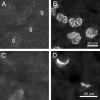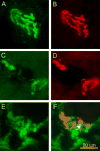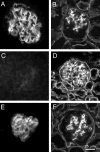Transgenic isolation of skeletal muscle and kidney defects in laminin beta2 mutant mice: implications for Pierson syndrome
- PMID: 16452099
- PMCID: PMC1363729
- DOI: 10.1242/dev.02270
Transgenic isolation of skeletal muscle and kidney defects in laminin beta2 mutant mice: implications for Pierson syndrome
Abstract
Pierson syndrome is a recently defined disease usually lethal within the first postnatal months and caused by mutations in the gene encoding laminin beta2 (LAMB2). The hallmarks of Pierson syndrome are congenital nephrotic syndrome accompanied by ocular abnormalities, including microcoria (small pupils), with muscular and neurological developmental defects also present. Lamb2(-/-) mice are a model for Pierson syndrome; they exhibit defects in the kidney glomerular barrier, in the development and organization of the neuromuscular junction, and in the retina. Lamb2(-/-) mice fail to thrive and die very small at 3 weeks of age, but to what extent the kidney and neuromuscular defects each contribute to this severe phenotype has been obscure, though highly relevant to understanding Pierson syndrome. To investigate this, we generated transgenic mouse lines expressing rat laminin beta2 either in muscle or in glomerular epithelial cells (podocytes) and crossed them onto the Lamb2(-/-) background. Rat beta2 was confined in skeletal muscle to synapses and myotendinous junctions, and in kidney to the glomerular basement membrane. In transgenic Lamb2(-/-) mice, beta2 deposition in only glomeruli prevented proteinuria but did not ameliorate the severe phenotype. By contrast, beta2 expression in only muscle restored synaptic architecture and led to greatly improved health, but the mice died from kidney disease at 1 month. Rescue of both glomeruli and synapses was associated with normal weight gain, fertility and lifespan. We conclude that muscle defects in Lamb2(-/-) mice are responsible for the severe failure to thrive phenotype, and that renal replacement therapy alone will be an inadequate treatment for Pierson syndrome.
Figures









Similar articles
-
A missense LAMB2 mutation causes congenital nephrotic syndrome by impairing laminin secretion.J Am Soc Nephrol. 2011 May;22(5):849-58. doi: 10.1681/ASN.2010060632. Epub 2011 Apr 21. J Am Soc Nephrol. 2011. PMID: 21511833 Free PMC article.
-
Laminin β2 gene missense mutation produces endoplasmic reticulum stress in podocytes.J Am Soc Nephrol. 2013 Jul;24(8):1223-33. doi: 10.1681/ASN.2012121149. Epub 2013 May 30. J Am Soc Nephrol. 2013. PMID: 23723427 Free PMC article.
-
Forced expression of laminin beta1 in podocytes prevents nephrotic syndrome in mice lacking laminin beta2, a model for Pierson syndrome.Proc Natl Acad Sci U S A. 2011 Sep 13;108(37):15348-53. doi: 10.1073/pnas.1108269108. Epub 2011 Aug 29. Proc Natl Acad Sci U S A. 2011. PMID: 21876163 Free PMC article.
-
Alport syndrome and Pierson syndrome: Diseases of the glomerular basement membrane.Matrix Biol. 2018 Oct;71-72:250-261. doi: 10.1016/j.matbio.2018.04.008. Epub 2018 Apr 16. Matrix Biol. 2018. PMID: 29673759 Free PMC article. Review.
-
Mutations in the human laminin beta2 (LAMB2) gene and the associated phenotypic spectrum.Hum Mutat. 2010 Sep;31(9):992-1002. doi: 10.1002/humu.21304. Hum Mutat. 2010. PMID: 20556798 Free PMC article. Review.
Cited by
-
Pathogenic LAMA5 Variants and Kidney Disease.Kidney360. 2021 Dec 30;2(12):1876-1879. doi: 10.34067/KID.0007312021. eCollection 2021 Dec 30. Kidney360. 2021. PMID: 35419542 Free PMC article. No abstract available.
-
Blocking CHOP-dependent TXNIP shuttling to mitochondria attenuates albuminuria and mitigates kidney injury in nephrotic syndrome.Proc Natl Acad Sci U S A. 2022 Aug 30;119(35):e2116505119. doi: 10.1073/pnas.2116505119. Epub 2022 Aug 22. Proc Natl Acad Sci U S A. 2022. PMID: 35994650 Free PMC article.
-
Mesencephalic astrocyte-derived neurotrophic factor (MANF), a new player in endoplasmic reticulum diseases: structure, biology, and therapeutic roles.Transl Res. 2017 Oct;188:1-9. doi: 10.1016/j.trsl.2017.06.010. Epub 2017 Jun 29. Transl Res. 2017. PMID: 28719799 Free PMC article. Review.
-
Proteinuria precedes podocyte abnormalities inLamb2-/- mice, implicating the glomerular basement membrane as an albumin barrier.J Clin Invest. 2006 Aug;116(8):2272-9. doi: 10.1172/JCI28414. J Clin Invest. 2006. PMID: 16886065 Free PMC article.
-
The proteomic profile of the human myotendinous junction.iScience. 2022 Jan 29;25(2):103836. doi: 10.1016/j.isci.2022.103836. eCollection 2022 Feb 18. iScience. 2022. PMID: 35198892 Free PMC article.
References
-
- Abrahamson DR, Irwin MH, St John PL, Perry EW, Accavitti MA, Heck LW, Couchman JR. Selective immunoreactivities of kidney basement membranes to monoclonal antibodies against laminin: localization of the end of the long arm and the short arms to discrete microdomains. J Cell Biol. 1989;109:3477–3491. - PMC - PubMed
-
- Aumailley M, Bruckner-Tuderman L, Carter WG, Deutzmann R, Edgar D, Ekblom P, Engel J, Engvall E, Hohenester E, Jones JCR, et al. A simplified laminin nomenclature. Matrix Biol. 2005;24:326–332. - PubMed
-
- Burgeson RE, Christiano AM. The dermal-epidermal junction. Curr Opin Cell Biol. 1997;9:651–658. - PubMed
-
- Eremina V, Wong MA, Cui S, Schwartz L, Quaggin SE. Glomerular-Specific Gene Excision In Vivo. J Am Soc Nephrol. 2002;13:788–793. - PubMed
Publication types
MeSH terms
Substances
Grants and funding
LinkOut - more resources
Full Text Sources
Other Literature Sources
Medical
Molecular Biology Databases

